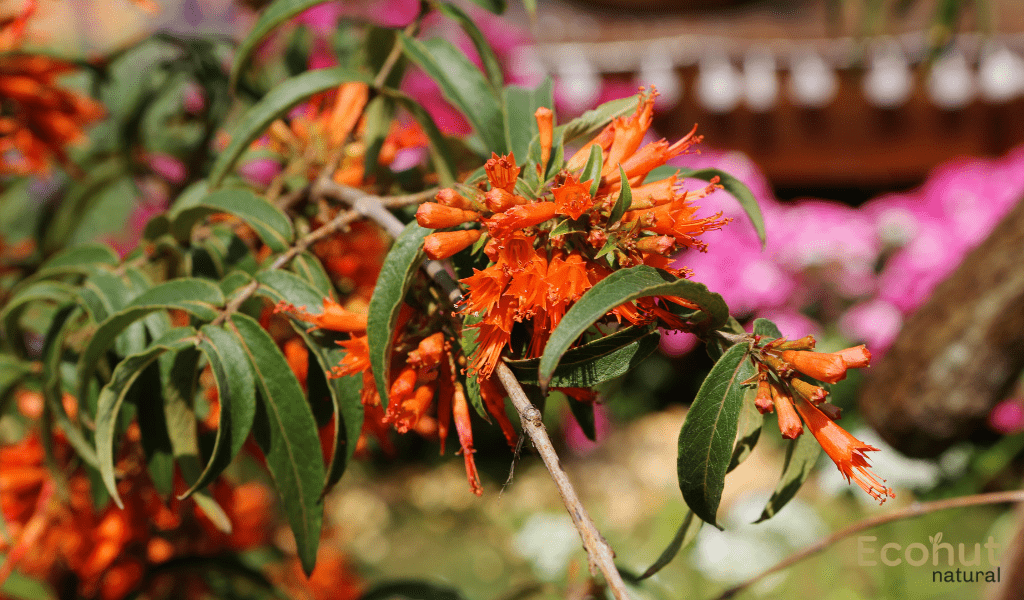Dhataki,(Woodfordia fruticosa) also known as the Fire Flame Bush, is a member of the Lythraceae family and is scientifically known as Woodfordia fruticosa L. Although it originated in India, Madagascar, Pakistan, Bhutan, Myanmar, Ceylon, Nepal, Indonesia, and China also have large availability of it. Dhataki is widely available in West Bengal, Mizoram, and Arunachal Pradesh, India.
In Ayurveda, Dhataki or Dhawai is also called Bahupuspika. The Dhataki flower is the one that matters most in traditional Indian medicine.
Other names for Dhataki (Woodfordia Fruticosa) include Shinajitea, Woodfordia, and fire flame Bush. This plant has been employed by our acharyas in Ayurveda and is described in ancient Scriptures for treating a variety of ailments.
Description
The deciduous shrub Dhataki has spreading branches that can grow up to 12 meters in height. Typically, branches have multiple spreading lengths and a tall, fluted stem. The shrub’s bark is smooth and has a reddish brown color. Description
Botanical Name:
Woodfordia fruticosa
Family:
Lythraceae
Leaves:
The lower surface of the broad, lanceolate leaves is pale. They have a length of 5 to 9 cm.
Stems:
The bark is smooth and reddish-brown, and the branches are long and spreading.
Flowers:
The blossoms are the most noticeable feature of the plant. Because of their vivid red hue, Dhataki is known as the “fire flame bush.” Along the twigs and branches, the tiny blooms grow either alone or in clusters. Every flower features six petals that are marginally longer than the calyx tooth, a little stem, and a thin tube with a curled, greenish base.
Fruits:
The fruits are membrane-bound ellipsoid capsules. They have many tiny brown seeds within, and they are roughly 1 cm long.
Habitat:
Native to Asia and Africa, dhataki is a medicinal herb used in Ayurvedic medicine.It grows widely throughout northern India, reaching elevations of up to 1500 meters. It can be found in waste areas and open grasslands, although it is also grown in gardens in the summer in Madagascar, Pakistan, Ceylon, Nepal, Bhutan, and Myanmar.China and Indonesia.The woodfordia plant is found in West Bengal, Mizoram, and Arunachal Pradesh in India.
Parts Used:
Leaves, Fruits, Flower, Gum
Chemical Constituents:
The main constituents found in Dhataki flowers include beta-sitosterol, cyaniding, octasonal, diglucoside, and tannins. Ellagic acid, polystachoside, pelargoidine-3, and 5-diglucoside are all present in leaves.
Dosage:
Powder-3-6gm
Botanical Description
Dhataki (Woodfordia Fruticosa) has several fluted branches that can reach heights of five to twelve meters. The stem is long and fluted, and the branches are spreading. Its bark has thin, smooth, fibrous streaks that give it a reddish-brown color.
Medicinal Properties
- Trshnahara -reducesthirst
- Pramehahara-cures diabetes
- Sulaghna-alleviates pain
- Swasahara-relieves asthma
- Dipana-as carminative
- Krimighna-useful in worm infestations
- Kushtaghana-relieves skin diseases
- Jwaraghna-useful in fever
- Arsoghna-useful in treating piles
Other Language Names of Dhataki (Woodfordia fruticosa)
Farsi name – Dhaava
Oriya name – Jaliko, Harwari, and Dhobo
Gujarati name – Dhaavadi
Bihar name – Dawai, Dhai
Nepali name – Dhangera
Hindi name – Dhai, Ban-mahendi, Dhati, Dhatri, Dhatki, Dhaura
Sanskrit name – Agnijwala
Malayalam name – Tatire, Tamarpushi, Tatiripushpi
Tamil name – Dhattari, Dhathari-jagri
Kannada name – Taamra pushpin, Bela, Daathakee kusumka
Telugu name – Dhaathaki, Dhaarhupushpika
Tibetan name – Me-togda tak ki, Dha-ta-ke,
Urdu name – Gul dhawa
Bengali name – Dhai, Dhai phul, Dawai
Marathi name – Dhayati, Dhalas, Dhadva
Jammu and Kashmir name – Thwai
Punjabi name – Dhavi
Scientific Classification
| Kingdom | Planatae |
| Order | Myrtales |
| Genus | Woodfordia |
Ayurvedic Properties
Hindi/Sanskrit
- Rasa-Kashaya
- Guna-Ruksha,Laghu
- Virya-Sheeta
- Vipaka-Katu
English
- Taste-Astringent
- Physical Property-Light,Dry
- Potency-Cold
- Metabolic Property (After Digestion)-Pungent
Dhataki (Woodfordia fruticosa) Uses
Powder:
Dhataki flowers can be finely powdered after being dried. This powder can be made into a therapeutic paste by mixing it with honey or warm water. You can consume this paste to treat respiratory conditions including bronchitis and asthma.
Decoction:
Boil the Dhataki flowers in water until they reduce to half of their original quantity to make a Dhataki decoction. When taken in modest doses, this concentrated liquid helps to relieve menstruation pain and manage menstrual problems. In addition, it supports women’s reproductive health by acting as a uterine tonic.
Dhataki Elixir:
Soak the blooms of Dhataki in a mixture of water and honey to make a nutritious elixir. Give it a few days to infuse so the floral scent can combine with the liquid. This elixir promotes general well-being and immunity as a general health tonic. Take a tiny amount each day to reap its all-encompassing advantages.
Dhataki (Woodfordia fruticosa) Benefits
Wound healing:
Dhataki reduces edema, speeds up wound healing, and restores the skin’s natural texture. A paste made from the powdered Dhataki flower and coconut oil speeds up wound healing and lowers inflammation. It’s Ropan (healing) and Sita (cool) qualities are the reason for this.
Sunburn:
Dhataki helps protect against sunburn. Ayurveda says that sunburn is caused by the Pitta dosha becoming more aggravated. This is a result of constant sun exposure. Because Dhataki flower paste has both Sita (cold) and Ropan (healing) properties, applying it has a cooling effect and lessens burning sensation.
Fights Respiratory Issues:
Strong anti-inflammatory, antibacterial, and anti-asthmatic qualities make dhataki a well-known traditional treatment for a variety of respiratory conditions. It is essential for treating symptoms of the common cold, flu, sore throat, and cough. As a pacifier for the Kapha energy type, it actively thins and loosens catarrh particles in the nasal and chest cavities, which facilitates breathing and aids in the body’s mucus removal.
Digestive Harmony:
Dhataki helps with digestion, reducing bloating and other problems like indigestion. It encourages effective metabolism and the absorption of nutrients by subtly arousing the digestive fire.
Respiratory Health:
Dhataki is a great treatment for respiratory conditions because of its inherent decongestant qualities. Dhataki promotes easy and unobstructed breathing by acting as a calming balm.
Augments Skin Health:
An escalation of the Pitta doshas in the body can frequently result in various skin diseases, dermatitis, acne, and uneven skin tone. Blessed with antiseptic, antibacterial, and anti-inflammatory qualities, Dhataki is recognized by Ayurveda as an effective cure-all for a range of skin ailments. Because of its blood-purifying properties, which aid in eliminating toxins from the blood, it also aids in the treatment of numerous skin ailments.
Also Read: Lavanga, Clove (Syzygium aromaticum): Benefits and Side Effects
Dhataki (Woodfordia fruticosa) Side Effects
Generally Safe with Cautions:
Dhataki has always been regarded as somewhat safe when taken in accordance with Ayurvedic dosages. Nonetheless, there are a few possible issues.
Interaction with Medications:
Dhataki and several medicines may interact. Before using Dhataki, it is imperative that you speak with your doctor if you are on any drugs, particularly blood thinners or those that have an impact on blood sugar regulation.
Pregnancy and Breastfeeding:
It’s uncertain if Dhataki is safe for women who are nursing or pregnant. It is advisable to steer clear of it during these periods without first speaking with a medical expert.
Conclusion
Dhataki (Woodfordia Fruticosa) helps in treating diarrhea as well as dysentery due to astringent properties and also treats various bleeding disorders like nasal bleeding Kumar actor bleeding, menorrhagia, etc. Because of its cooling qualities, it also works well to cure a variety of skin conditions and excessive thirst. But its excessive dose may cause delirium so before using this herb you should consult your doctor.
FAQS
What is dhataki’s botanical name?
Dhataki, also known as Woodfordia fruticosa (L.) Kurz., is a significant medicinal plant used in Ayurvedic medicine.
Is Dhataki used to cure diarrhea?
Yes, the astringent properties of dhataki (Woodfordia Fruticosa) help treat diarrhea. It not only regulates the frequency of the loosening stool but also thickens it.
What are the dhataki plant’s advantages?
Advantages of dhataki. Dhataki reduces edema, speeds up wound healing, and restores the skin’s natural texture. A paste made from the powdered Dhataki flower and coconut oil speeds up wound healing and lowers inflammation. It’s Ropan (healing) and Sita (cool) qualities are the reason for this.
What is the dhataki’s habitat?
Africa and Asia are home to the woodfordia fructicosa plant, or dhataki. It is found throughout northern India, up to an elevation of 1500 meters. Although it is mostly grown in wastelands and open grasslands, it is also grown in gardens in the summer.

